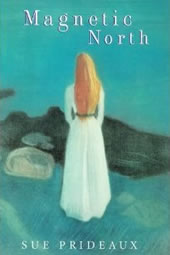Published by Little, Brown
Magnetic North (Little, Brown & Company, 1988) is Sue Prideaux’s last novel. Set largely in Norway during the late nineteenth and early twentieth century it was described by Margaret Forster as ‘a gothic novel in the best sense…and even a romantic on in the way Tolstoy is romantic’.
Sue Prideaux’s research for the novel developed into a deep fascination for Scandinavian history, culture and art of the period. Ultimately, it led her to abandon fiction for biography, her debut being that of Edvard Munch.
A vast novel, historically, geographically and morally. Magnetic North sweeps from the plains of Russian Revolution through Norway’s frozen wastes to the jazz-age Riviera. The constant fight to reconcile the polar opposites of free will and destiny, duty and hedonism, continuity and change makes a superb piece of story-telling.
1917. War or no war, monied Europe continues to feel the need for winter sunshine. Gustav Oscarsson and Katya Olovanova, two trembling swallows from the frozen North fly south to bask in the warmth of the Riviera – she from the forests round Moscow, he from Oslo and a narrow squeak with a lady magician. Gustav brings Katya back to Oslo as a bride. Now, Oslo observes, both Oscarsson brothers have fine wives: Charlotta, pretty, transparent, elegant controlled; and the tempestuous Katya, whom Oslo society admires with a salacious shudder – the Bolshevik’s massacre of her family in the forest hanging about her like a shadowy blood-mist. When Katya vanishes in San Francisco, Charlotta is left with the pieces – and with the daughter, the second Katya, echo of the first, who burns as brilliantly as her mother, two comets on an inevitable parabola of destruction. As Norway waits for the Germans to come, suffers the humiliation and deprivation of being occupied by Nazi forces, and tries to come to terms with a post-war world, the Oscarssons face death, scandal and tragedy. And would any of this have happened if Katya had not been leaning on the balustrade in Riva del Garda in 1917?
